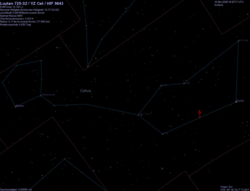| Observation data Epoch J2000 Equinox J2000 | |
|---|---|
| Constellation | Cetus |
| Right ascension | 01h 12m 30.6369s [1] |
| Declination | −16° 59′ 56.358″ [1] |
| Apparent magnitude (V) | 12.03 - 12.18 [2] |
| Characteristics | |
| Evolutionary stage | red dwarf |
| Spectral type | M4.0Ve [3] |
| U−B color index | +1.430 [4] |
| B−V color index | +1.811 [4] |
| Variable type | Flare star [5] |
| Astrometry | |
| Radial velocity (Rv) | +28.09 [6] km/s |
| Proper motion (μ) | RA: 1,205.074 [1] mas/yr Dec.: 637.547 [1] mas/yr |
| Parallax (π) | 269.0573±0.0337 mas [1] |
| Distance | 12.122 ± 0.002 ly (3.7167 ± 0.0005 pc) |
| Absolute magnitude (MV) | 14.30 [3] |
| Details | |
| Mass | 0.130±0.013 [7] M☉ |
| Radius | 0.168±0.009 [7] R☉ |
| Luminosity | 0.002195 [8] L☉ |
| Surface gravity (log g) | 5.20 [8] cgs |
| Temperature | 3056±60 [7] K |
| Metallicity [Fe/H] | −0.26±0.08 [7] dex |
| Rotation | 79.82±2.09 [9] days |
| Rotational velocity (v sin i) | 3.40 [10] km/s |
| Age | 5.0±1.0 [7] Gyr |
| Other designations | |
| GCTP 248.01, GJ 54.1, HIP 5643, G 268-135, L 725-32, LHS 138, LTT 670, 2MASS J01123052-1659570 | |
| Database references | |
| SIMBAD | data |
| Exoplanet Archive | data |
YZ Ceti is a red dwarf star in the constellation Cetus. Although it is relatively close to the Sun at just 12 light years, this star cannot be seen with the naked eye. It is classified as a flare star that undergoes intermittent fluctuations in luminosity. YZ Ceti is about 13 percent the mass of the Sun and 17% of its radius.
Contents
This star is unusually close to Tau Ceti, a star of spectral class G8. The two are only about 1.6 light years apart, [11] a little more than a third of the distance from the Sun to the Solar System's nearest neighbor, Proxima Centauri.




